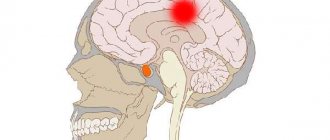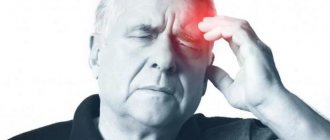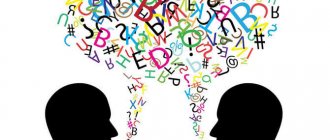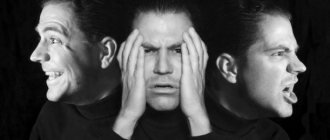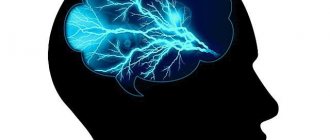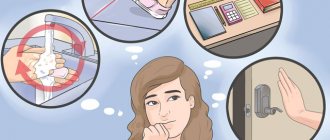Among a number of aphasic disorders, acoustic-mnestic disorders occupy a special place.
What acoustic-mnestic aphasia is, why and under what problems does this memory lesion occur in the body, what disorders it leads to, what are the features of diagnosis and correction will be discussed below.
What is the reason?
The appearance of the disorder is the result of damage to certain areas of the cerebral cortex. Pathology occurs in the temporal part of the dominant hemisphere , in its mid-posterior sections. These are the so-called Brodmann cytoarchitectonic areas 21 and 37. For most people, the left hemisphere is dominant.
Disruption of the functioning of these departments can occur due to deterioration of blood circulation in this place, inflammatory processes, and trauma.
As a result of the latter, the integrity of the brain structures is disrupted or compression occurs:
- Stroke .
The most common factor in this type of aphasia. An ischemic stroke leads to insufficient blood supply and oxygen starvation of the cerebral cortex. In a hemorrhagic stroke, blood leaking from damaged vessels compresses the brain tissue. - Traumatic brain injuries . The damage received during the injury itself is accompanied by swelling, which puts pressure on the brain structures. An inflammatory process may also begin.
- Intracerebral tumors . Any formations (both malignant and benign) lead to disruption of brain activity due to increasing pressure on neighboring areas and the vessels from which they feed. If the tumor grows into the brain structure itself, the latter is destroyed.
- Diseases of an infectious nature . Any inflammation of the brain substance or its membranes (encephalitis, meningitis, cerebral abscesses) causes dysfunction of neurons that participate in the process of speech formation. Inflammation leads to swelling and compression, which leads to disruption of connections between neurons.
- Progressive degenerative processes . A number of diseases (Alzheimer's disease, Pick's disease, Schilder's leukoencephalitis), which are accompanied by damage to certain hemispheric lobes and destruction of the myelin sheath of nerve fibers, in the initial stages cause acoustic-mnestic dysfunction.
Classification
The definition of amnestic aphasia includes 2 types of speech disorders:
- Opticonesthetic aphasia
Develops due to damage to the occipital and temporal parts of the brain in the left hemisphere. The patient does not experience a decrease in vocabulary; the person forgets what objects look like, not their names.
- Acousticomnestic aphasia
The gyri of the middle temporal part and the area of the auditory apparatus are affected. As a result, the patient's speech and auditory memory volume decreases.
In most cases, the diagnosis of amnestic aphasia implies the presence of a set of problems in the patient, that is, the forms of the disease are combined with each other.
Many specialists in Russia use the classification of A.R. when diagnosing such disorders. Luria, who identified many more varieties of aphasia:
- Efferent motor
Patients do not perceive information from written text, cannot fully read and write, make many spelling and punctuation errors, and create text from sentences that are incoherent in meaning.
- Afferent motor
The patient has difficulty speaking and has difficulty selecting an articulatory unit.
- Dynamic
People find it difficult to form sentences, phrases of 3 or more words, and in speech they jump from one thought to another.
- Sensory
A person has impaired phonemic hearing. He understands other people's speech poorly, even in his native, well-known language.
- Semantic
The patient perceives speech only in short phrases and sentences and is unable to analyze complex semantic structures.
Pathogenesis
In people suffering from acoustic-mnestic aphasia, auditory-verbal memory is impaired. Presumably, this is due to excessive inhibition of auditory-verbal traces.
That is, tracking activity is not disrupted (traces are recorded and not forgotten), but is slowed down and drowned out by further information. It is easier for the patient to repeat a single word than a series. In addition, a person’s auditory-verbal memory capacity decreases, which aggravates the situation.
Often, when the 37th Brodmann area is damaged, its connection with the structures of the occipital lobe, which carry an optical-gnostic load, is disrupted, i.e. are responsible for visual and cognitive perception, which is where acoustic-mnestic aphasia arises.
Main symptoms and central mechanism of pathology
Impressive speech is impaired, but not grossly, i.e. understanding of what is heard suffers . It is difficult for the patient to correlate the visual image of an object and its linguistic shell, and difficulties arise in understanding the meaning of the statement.
A distinctive feature of acoustic-mnestic aphasia is the following: when a person hears new words, he forgets those that were heard before. This makes it difficult to understand the overall meaning of the statement.
It is difficult for the patient to unravel the hidden subtext of what he heard, allegories, and allegorical references . At the same time, short, situational statements are easy to understand. The situation is different with the comprehension of detailed speech production.
In severe acoustic-mnestic aphasia, spontaneous speech consists of short phrases and a poor vocabulary. It is difficult for the patient to find the right word. With a mild degree, speech is more developed, but it is difficult to make statements with subordinate constructions, participial and participial phrases.
In addition, the symptomatic picture of acoustic-mnestic aphasia is characterized by verbal paraphasia, difficulty understanding speech in conditions of increased complexity (fast pace, simultaneous presentation of two speech messages), difficulty writing from dictation, and a symptom of alienation of the meaning of a word.
Which symptoms are not related to this pathology:
- phonemic hearing impairment;
- impairment of sound discrimination;
- literal paraphasias;
- incoherent, unproductive conversational speech.
Read about the symptoms of other memory disorders: manifestations of hyperthymesia, signs of deja vu, jamevu and presquevu.
Sensory aphasia (acoustic-gnostic)
⇐ PreviousPage 18 of 25Next ⇒
Sensory aphasia occurs when the posterior third of the superior temporal gyrus of the left hemisphere (22nd field) is damaged. The central mechanism underlying this defect is a violation of the acoustic analysis and synthesis of speech sounds. This manifests itself in phonemic hearing , serving as a central defect in sensory aphasia. In this case, a violation of the level of phonetic organization of speech , which creates difficulties in sound discrimination. The sound of a word loses its constancy and stability; therefore understanding, repeating, pronouncing words becomes difficult or impossible. The discrimination of correlative phonemes is impaired, which differ in the language: a) by voicedness-voicelessness (b-p, d-t), b) by hardness-softness (l-l, t-t), c) by nasality (n-t and m-d). Patients with sensory aphasia cannot differentiate these signs of sounds, and therefore replace them with close phonemes, which leads to the central symptom - a violation of speech understanding.
In the clinical picture, this defect manifests itself in the phenomenon of alienation of the meaning of words, in a violation of the understanding of words, verbal constructions, and addressed speech. In all types of oral speech, the abundance of literal paraphasias attracts attention. Spontaneous speech is unproductive or completely unproductive; it is grammatically impaired. In such grossly disrupted speech, the general outline of the phrase remains intact. The general intonation structure of the utterance may remain undisturbed, i.e. the syntagmatic organization of speech is more preserved. Patients with sensory aphasia are sociable; they replace the deficit of verbal means of communication with paralinguistic methods: facial expressions, gestures, and preserved intonation. Patients with such aphasia are not able to perceive differences in the sound of words such as class - voice, can - python, byl - dust - was - drank, as a result of which paragnosis and disturbances in understanding the meaning of words arise. The naming of objects is also disrupted: ceiling - dragged - pokolo - striped - toposkal. Oral speech is characterized by multiple attempts at repetition and general verbosity. Their speech is emotionally colored, richly intonated, and the tempo is significantly accelerated.
Impaired speech understanding begins with a lack of understanding of the simplest instructions, but patients can grasp the meaning of the statement.
The neuropsychological syndrome includes : 1) impairment of all types of oral expressive speech; 2) impairment of reading and writing; 3) violation of oral counting due to defects in the analysis of sounds; 4) disturbances in rhythm reproduction; 5) disturbance of emotions: patients are anxious, they are easily excitable, easily and quickly move from one emotional state to the opposite.
The psychological picture reveals violations of almost all speech functions. Their psychological level of understanding of the general meaning is preserved; in the lexico-grammatical sense, the sound distinction link is grossly violated. They have a violation of the objective attribution of the word due to the collapse of the sound structure. All mental processes not associated with acoustic gnosis remain intact.
An example of oral speech of a patient with sensory aphasia.
Psychologist: “Tell me about the North.” Answer: “I was in the army in Vladivostok...March...sailors? Yes, the sailors... were all there... watching... packing up and leaving... Sailors... how could this be? Lord, metro stations... It’s generally good there.” Understanding words (the patient is given a word, he must find the corresponding picture): bread - points to the ball, eyes - points to the mouth, suitcase - points to the phone. Understanding instructions : “Stand up and walk to the door” - gets up and stands. "Here you are". “Come to the door” - (stands). Here I am... well, you can here (comes to the window).
Acoustic-mnestic aphasia
As a result of damage to the middle parts of the left temporal lobe (fields 21 and part of the 37th), another form of temporal aphasia occurs, which is distinguished by the presence of several central mechanisms: a narrowing of the volume of acoustic perception and a violation of visual object images and representations. Its central defects are impaired understanding of speech, repetition; oral spontaneous speech is secondarily impaired, which is accompanied by a large number of verbal paraphasias.
Phonemic hearing remains intact.
The clinical picture manifests itself in a mild impairment of understanding speech and alienation of the meaning of words, a lack of understanding of the meaning of the hidden subtext of a statement, a violation of the naming of objects, and a mild impairment of oral speech. There is a symptom of alienation of the meaning of words when repeated correctly. Violation of oral expressive and impressive speech occurs against the background of significantly intact reading and writing. In expressive speech there is no incoherent, unproductive conversational speech; speech can be understandable to the interlocutor. Often these patients notice their mistakes in speech, they do not have verbosity, and the emotional side of speech is not increased. In acoustic-amnestic aphasia, patients' attempts to name an object are aimed at searching for the desired word-name.
The neuropsychological syndrome includes symptoms: impaired speech understanding; alienation of the meaning and meaning of words; disorders of oral expressive speech – spontaneous, repeated; violations of the nominative function of speech, perception and evaluation of rhythms. All types of praxis and gnosis are preserved.
In the psychological picture, a violation of speech understanding, alienation of the meaning of a word occurs against the background of intact phonemic hearing and the process of sound discrimination. The central mechanism of this aphasia is considered to be a violation of operational auditory-speech memory . In patients, fresh memory traces are read better than previous ones, so an increase in information strengthens the defect. While not experiencing difficulty repeating individual words, patients find it difficult as soon as they are asked to repeat a series of words. Violation of the process of naming objects is associated with defects in object images, the sensory basis of the word. This defect can occur against the background of good spontaneous speech and a mild impairment of speech understanding. The phenomenon of alienation of the meaning of a word is associated with the instability of visual object images. There is another mechanism - a narrowing of the volume of perception, which leads to defects in repeated speech and understanding of addressed speech. Reading and writing are accessible to patients.
An example of oral speech of a patient with acoustic-mnestic aphasia.
Psychologist: “Tell me how you were wounded?” Answer: “Wounded... in August... around this... I’ll tell you right now... well, this... the company commander was... a lieutenant... I had to leave... It was in this... what is it called... and this... in a trench... for every trench.
Naming objects after presenting their drawing: suitcase - watch... no, that's not a watch, it's on a business trip; tree - forest; closet - well, it was just now, I know, there are all sorts of things there.
Semantic aphasia
The parieto-occipital regions of the left hemisphere (fields 39, 40, part 19 and 37) connect the visual, auditory and skin sensitivity fields. This zone turns information into simultaneous patterns. Speech disorders with damage to these fields are called semantic aphasia. This aphasia is based on defects in simultaneous, simultaneous grasping of information, and disturbances in spatial perception.
The central mechanism (factor) of impaired understanding of speech will be a violation of simultaneous spatial perception, and the central defect will be a violation of the understanding of logical-grammatical structures.
In the clinical picture there is no gross impairment of expressive speech: patients can speak using simple sentence structures and understand simply constructed speech. They do not have reading or writing impairments. They find it difficult to navigate in space. Complicating the grammar of speech leads to misunderstanding of the interlocutor’s speech and confusion.
Semantic aphasia occurs in the neuropsychological syndrome of simultaneous agnosia, astereognosis, disturbance of the body diagram, spatial and constructive apraxia and primary acalculia (impaired counting). The perception of subtle spatial relationships and the relationships of objects in space is disrupted. Patients recognize objects, understand the meaning of a plot picture, but cannot correctly perceive the spatial relationships of objects relative to one another. They cannot mentally flip a figure in space. They have impaired perception of a geographical map, recognition of time by a clock, impaired understanding of number digits, and counting operations. So, all their mental processes, the structure of which includes the factor of simultaneous spatial perception . This syndrome involves peculiar speech disturbances. There is a defect in the simultaneous perception of an entire complex sentence, and the meaning of the sentence can only be understood on the basis of simultaneous perception of a logical-grammatical structure. With this aphasia, the understanding of constructions with prepositions ( under, above, from, to, for, in, on, because of)
etc.) since they reflect real spatial relationships.
The understanding of comparative constructions ( a pug is smaller than an elephant
), phrases with words
before, after, without,
instrumental case constructions (
show the map with a pointer
), genitive case constructions (
grandfather’s boat, baby’s pacifier
) is impaired. When assessing such constructions, the patient is unable to access the relationships and interactions of objects and phenomena.
Psychological picture. Patients with semantic aphasia understand everyday speech addressed to them, answer questions adequately, and difficulties in oral speech do not go beyond easy forgetting of words. They have a gross violation of the semantic structure of speech. Understanding of speech is available within simply constructed phrases, while the perception and understanding of complex grammatical and logical-grammatical relationships of words in a phrase is impaired. These patients have impaired understanding of the meaning of words united by the instrumental case construction.
Inversions , i.e. phrases with reverse word order (the grass is blown by the wind) are incomprehensible, while understanding simple phrases with direct word order (the wind blows on the grass) is intact. The comparative construction of phrases makes it difficult to recognize the meaning behind them (Grandfather is taller than his grandson. Who is shorter?). Defects in speech understanding are especially pronounced when perceiving speech with prepositions. Thus, with semantic aphasia, the word falls out of the system of grammatical concepts and is perceived only as a carrier of meaning . They classify the words crying, running as verbs, and blushing, becoming prettier as adjectives. Patients cannot be distracted from the material side of the word.
We give an example of speech understanding in patients with semantic aphasia.
The speech therapist asks you to repeat the phrase: “The elm leaf rustles in the wind.”
Patient: “I don’t understand... The knitted leaf is rustling... I don’t understand.”
The speech therapist helps him parse the sentence: “What are we talking about here?”
Patient: “Well, the tree is growing, the leaves are rustling.”
Speech therapist: “Tell me which sentence is correct: A sparrow is larger than an eagle or an eagle is larger than a sparrow.”
Patient: “Oh, this is very difficult.”
Speech therapist: “Which sentence is correct?”
Patient: “So...(Reads aloud)...No...that’s what I don’t understand.”
Amnestic aphasia
Amnestic aphasia occurs when the posterior temporal and parieto-occipital regions of the brain are damaged. The only and central symptom is difficulty in naming objects. This aphasia is based on two factors . The first is associated with defects in the optical perception of an object, with defects in identifying its essential features. The second is associated with a pathological condition of the cortex, which makes it difficult to select a word from several alternatives.
In the clinical picture, the first place is taken by the abundance of searches for word names and the abundance of verbal paraphasias in spontaneous oral speech. Of all the functions of speech, the nominative function is the first and most severely disrupted. When trying to name an object, patients list a group of words, but always from the same semantic field. Unlike sensory and acoustic-mnestic aphasia, a hint helps. This indicates that acoustic gnosis is preserved.
In the psychological picture, one can note a violation of the nominative function of speech. All types and forms of speech are not impaired. Reading and writing preserved. This form of aphasia is rare.
All forms of aphasia differ in clinical and psychological presentation and neuropsychological syndrome. The difference is based on a central mechanism (factor). The first task of a neuropsychologist is to isolate the mechanism and analyze the syndrome. Vascular lesions of the brain often lead to complex, mixed forms of aphasia.
Alalia
Alalia is the absence or limitation of speech in children, caused by underdevelopment or damage in the pre-speech period to the speech areas of the cerebral cortex: frontal or temporal. When making this diagnosis, deafness, mechanical anarthria and dementia must be excluded. There are motor, sensory and total alalia. With motor alalia, speech is impaired, but its understanding is preserved. Noteworthy is the absence or limitation of humming, late appearing and very poor babbling. The lack of speech in a 2-3 year old child should cause concern. If, with normal speech development, babbling appears in the second half of the first year of life, then in children with motor alalia babbling appears in the second and third years of life, which is why they are called “speechless.” By the end of the third year and later, children develop individual onomatopoeias or syllabic elements that are retained for a long time. The accumulation of vocabulary proceeds slowly and, as a rule, at the expense of nouns most often pronounced by parents. The structure of the word is disrupted: children use the first or stressed syllable, and simplification of syllabic elements is observed. At the age of 4-5 years, there is some activation of speech, enrichment of the vocabulary due to the simplest words in structure. Nouns are used in the nominative case, verbs - in the indefinite form. During this period, the lag in speech development becomes clearly visible. Gradually, a phrase begins to form, the structure of which is sharply disrupted due to agrammatisms. The poverty of the vocabulary remains. After 5 years of age, speech activation is noted; verbs appear along with nouns, but prepositions and objects are absent in speech. Thus, the stages of speech development can be traced: late speech development, slow accumulation of vocabulary, disruption of word structure, late accumulation of vocabulary and the formation of phrasal speech with pronounced agrammatisms, insufficient or complete absence of the communicative function of speech. Classes with children on speech development revealed difficulties in memorizing and composing phrases. The story based on the picture took place in the form of question-and-answer speech with the naming of individual objects; actions were not taken into account. Children showed insufficient interest in the speech of others.
Children with severe alalia should begin classes early with a speech therapist on speech development and attend a school for children with speech disorders. In milder cases, children should work with a speech therapist before school and during school, and continue classes with a school speech therapist to prevent dysgraphia.
In contrast to motor alalia with sensory , children are verbose even during the period of babbling speech. Against the background of preserved hearing, children have a speech perception disorder. In some cases, children hear words, repeat them, but do not correlate them with the object that denotes them. The “word-object” connection is not formed even with repeated repetitions. Children's behavior is correct, there is sufficient interest in their surroundings, and expressive speech is developing. A more severe version of sensory disorders are sensory disorders, when children do not understand the speech of the people around them and cannot repeat a word after the teacher. They perceive quiet or medium-volume sounds better, while loud sounds irritate them. They better perceive the speech of a person who constantly communicates with them, but they do not perceive the speech of a stranger at all. With sensory and total alalia, children's learning is extremely complicated.
All children with alalia need early identification and medical and pedagogical assistance to prepare for school. The intellectual development of children with alalia may approach normal.
Dysarthria
Dysarthria is a speech disorder caused by damage to the central nervous system, which manifests itself in disorders of articulation, phonation and breathing. Depending on the location of the lesion, several forms are distinguished: bulbar, pseudobulbar, cortical, mixed and cerebellar.
In the bulbar form, the pathological process involves the nuclei of the cranial nerves: trigeminal, facial, glossopharyngeal, vagus, sublingual, which innervate muscle groups of the articulatory apparatus involved in sound production, phonation and breathing. When the nuclei of the cranial nerves are damaged, paresis or paralysis is peripheral in nature, while the conduction of the nerve impulse is disrupted and the muscles atrophy. Dysarthritic disorders are especially noticeable when the hypoglossal nerve is damaged on one side, while the tip of the tongue deviates towards the paresis.
Pseudobulbar dysarthria is more common They arise when the cortical-stem pyramidal tract, which innervates the nuclei of the motor cranial nerves involved in articulatory movements, is affected. Dysarthria is complicated by secondary disturbances in the formation of the premotor and parietotemporal regions of the brain that occur after birth. In infants, there is a delay in humming and babbling. Subsequently appearing sounds turn out to be monotonous, quiet, rare, short-lived, without intonation. With age, the lexical development of a child’s speech is delayed. As a result of articulation disorders, the phonetic side of speech suffers. At the initial stage of speech development, many sounds are absent, which makes contact with others difficult. Subsequently, some sounds are formed, but speech remains blurred, poorly modulated, and slurred. Speech motor difficulties secondarily lead to disruption of the analysis of the sound composition of a word. Children do not distinguish sounds by ear and have difficulty repeating sounds and isolating sounds in words, which gives grounds to consider these disorders as phonetic-phonemic disorders.
Neurological symptoms, against which pseudobulbar dysarthria develops, are characterized by paresis and paralysis of the limbs and dysfunction of other cranial nerves.
Cortical dysarthria. In cases of damage to articulatory praxis, when the lower part of the postcentral gyrus is affected, a variant of cortical afferent apraxic dysarthria is observed. In these cases, the pronunciation of consonant sounds is disrupted, and articulation disorders are not constant. There is a search for the articulatory structure of speech, which slows down its pace and disrupts its smoothness.
The kinetic variant of cortical afferent apraxic dysarthria occurs when the lower parts of the premotor cortex of the left hemisphere are damaged. It is characterized by difficulty pronouncing complex sentences. The child’s speech is tense and slow. When studying articulatory praxis, difficulties in reproducing a series of sequential movements according to a task are noted.
With mixed dysarthria (extrapyramidal), muscle dystonia is observed in general and articulatory motor skills. Dystonia significantly distorts articulation, causing replacement and omission of sounds. Dystonia of the articulatory muscles is usually combined with hyperkinesis of the muscles of the face, tongue, lips, diaphragm, intercostal muscles, and therefore dysarthritic disorders are combined with breathing and phonation disorders.
The cerebellar form of dysarthria occurs when the pathways connecting the motor zone of the cerebral cortex with the brainstem and cerebellum are damaged. It is characterized by hypotonia of the articulatory muscles, as well as desynchronized breathing, phonation and articulation. Speech is slow, jerky, with impaired modulation, and the voice fades towards the end of the phrase. The neurological status of the patients is ataxia, movement coordination disorder.
Along with well-defined forms of dysarthria, erased, subtle ones are observed, in which articulatory and cerebral disorders are revealed during examination or functional load. Children with such disorders require special therapeutic and educational measures from an early age.
⇐ Previous18Next ⇒
Recommended pages:
Diagnostic measures
Diagnosis of the acoustic-mnestic form of aphasia requires the participation of different specialists and a set of studies. The patient should be consulted by a neurologist, psychiatrist, speech therapist, aphasiologist, and neuropsychologist. Based on the collected anamnestic data, a diagnosis is made.
Neurological examination
The neurological basis of the diagnosis is the identification of pathology of the cranial nerves, the presence of spastic hemiparesis, and impaired reflexes. A cognitive examination is also carried out to rule out mental disorders.
Speech examination
Features of speech activity are identified by a speech therapist and aphasiologist . When examining a patient with acoustic-mnestic dysfunction, verbal paraphasia, dyslexia, dysgraphia, and agrammatisms in speech will be detected.
Specialists will also pay attention to the level of auditory-verbal memory . The patient is asked to remember and reproduce a chain of ten short words that are not related to each other. Often the subject remembers only 1 word from the proposed ones, the last one.
Another task: 2 groups of lexical series of 3 words each are given. They also need to be remembered and retold. Most often, patients fail to cope with the task: they group words incorrectly and find it difficult to remember what exactly was called.
To examine auditory-verbal memory for a text, you are asked to listen to a short passage, retell it and answer questions. To record optical-gnostic disorders, the patient is asked to draw, for example, a cup or a teapot. If there is a pathology, the images will be missing details: a handle or spout.
Brain MRI
Magnetic resonance imaging will show the presence of tumor formations, foci of inflammation, degenerative changes, and traumatic injuries.
Vascular studies
To study blood vessels, ultrasound, duplex scanning, and MR angiography are prescribed . These studies make it possible to confirm or refute cerebrovascular pathology. They also show the characteristics of cerebral, collateral circulation, and the presence of vascular occlusion.
Lumbar puncture
To check for suspected neuroinfection, a lumbar puncture is performed. During the procedure, cerebrospinal fluid is taken from the patient. Laboratory examination of the material will show whether an inflammatory process is present, determine the pathogen, the presence of cancer cells, and signs of hemorrhage.
Differential diagnosis
When examined superficially, the symptoms of acoustic-mnestic disorder can be confused with signs of other speech disorders. Therefore, it is important to pay special attention to collecting anamnesis.
Thus, the difference between this type of aphasia and motor one lies in the activity of spontaneous speech. In acoustic-gnostic aphasia, as opposed to mnestic aphasia, the utterance is less complete and there are literal paraphasias. It is also necessary to distinguish between aphasia and cognitive impairment.
DYNAMIC APHASAIA
This aphasia occurs when there is damage to the posterior frontal parts of the left, speech-dominant hemisphere, the block of activation, regulation and planning of speech activity. And dynamic aphasia is characterized by the main speech defect - this is the difficulty, and sometimes the complete impossibility, of actively developing a statement. We can say that the basis of dynamic aphasia is a violation of the internal programming of the utterance, manifested in the difficulties of its planning when composing individual phrases.
Dynamic aphasia is based on a violation of spontaneous, detailed utterance. When retelling a plot picture, separate, unrelated fragments are pronounced, and the main semantic links are not highlighted.
Pseudo-amnestic difficulties may be observed when naming objects, especially when remembering the names of familiar people, names of cities, etc. The hint of the first syllable of a word can be a trigger that releases the inertia of the speech search for words. Significant difficulties are experienced when asked to perform a reverse ordinal count. For example, from ten to one.
Dynamic aphasia is characterized by intact reading and writing. Elementary counting in dynamic aphasia remains intact, but with this aphasia the solution of arithmetic problems that require the construction of an action plan is sharply impaired.
Organic lesions of the motor parts of the central nervous system caused by stroke (ischemic stroke, hemorrhage) contribute not only to speech impairment in the form of aphasia, but also to such speech disorders as dysarthria.
Treatment and correction
Treatment of the general disease that is the root cause of aphasia should be carried out in parallel with a corrective effect on the patient’s speech.
The consequences of a stroke require thrombolytic or hemostatic therapy. Surgery and radiotherapy are prescribed for tumor processes or brain hematomas. Antibiotic therapy is carried out to eliminate neuroinfectious diseases.
Speech therapy classes, exercises
It is advisable to start exercising from the moment the disease is diagnosed . Initially, the patient is asked to rely on visual perception, after which small dictations are carried out by ear. The complexity of the proposed exercises should gradually increase.
In classes with a speech therapist, work is carried out to expand the scope of speech perception. For this purpose, the following tasks are given:
- Follow the 2-3 step instructions (copy down the words, first grouping them by topic).
- Show parts of objects that are presented in groups of two or three.
- Listen to the text and answer the questions.
It is useful for a person suffering from an acoustic-mnestic form of aphasia to memorize and recall speech sequences, poems, songs, and compose sentences using reference words. To overcome the difficulty in choosing words for a statement, you can compare synonymous series, antonymic pairs, and clarify the meaning of lexemes.
Expressive speech is trained in the following tasks:
- Make up a story based on the pictures.
- Retell the text according to plan.
- Write a letter.
Drug therapy
Therapeutic measures for acoustic-mnestic aphasia involve restoring the functioning of neurons and connections between them. Treatment works best when stimulating metabolic processes in the brain structures.
The doctor prescribes nootropics to the patient (Piracetam, Nootropil, Memotropil, Noocetam, Noopept, Pantogam, Mexidol), neurometabolic drugs (gamma-aminobutyric acid), as well as drugs to improve vascular function (Vinpocetine, Cavinton, Bravinton).
Methods of correctional work for aphasia
The same teaching methods are used for left- and right-handed people. The main principle of speech restoration is to use the compensatory capabilities of the undamaged area of the brain. The duration of speech therapy sessions for all forms of aphasia is two to three years (in the hospital, then at home), but the patient should not be told about this. After examining the patient, the neurologist determines the form of aphasia. Corrective and rehabilitation work with a speech therapist begins with permission and under the supervision of the attending physician from the first weeks after a stroke or injury. In the early stages, the duration of classes should not exceed 15 minutes twice a week. In the later stages it lasts 30-40 minutes three times a day. The first stage is the same for all types of aphasia: speech disinhibition. They talk to the patient, observe his auditory perception, answers to questions, and understanding of speech. Further work is carried out depending on the form of the disease on all aspects of speech.
Forecast and prevention of the problem
Forecasts for the acoustic-mnestic type of aphasia can be made by knowing the genesis of the disease and taking into account the time when treatment was started.
Often, after strokes, traumatic brain injuries, or encephalitis, people restore speech function. However, this is preceded by a long therapeutic period.
If aphasia remains undiagnosed and is not subject to corrective action, then speech pathology will become persistent. The most unfavorable prognosis is given for aphasia resulting from a tumor or damage to brain structures .
Preventive measures include timely treatment of cerebrovascular diseases, identification of oncological factors, prevention of injuries, and strengthening of the immune system.
The acoustic-mnestic form of aphasic disorder does not always mean a final verdict . If the diagnosis is made correctly and treatment is started in a timely manner, the patient has a high chance of maintaining full-fledged activity.
